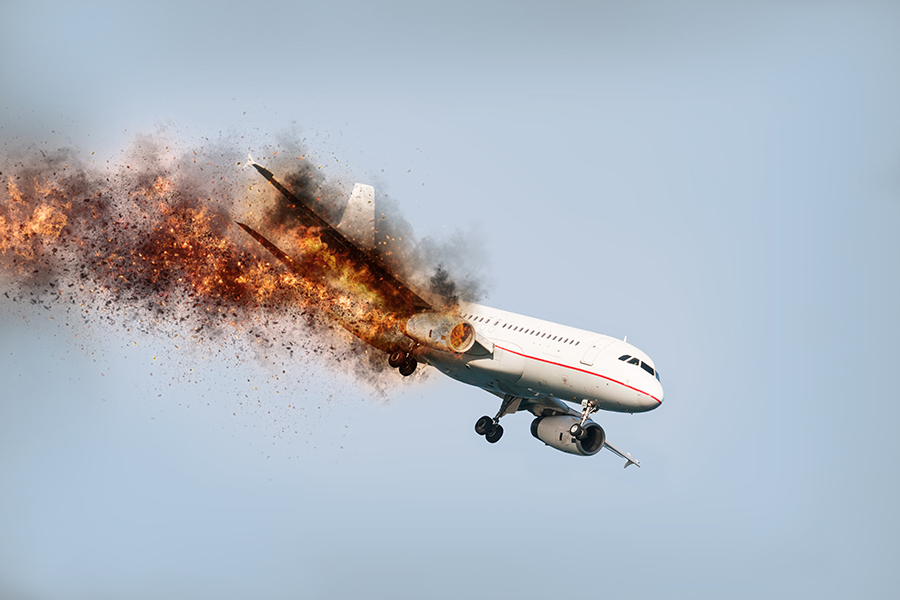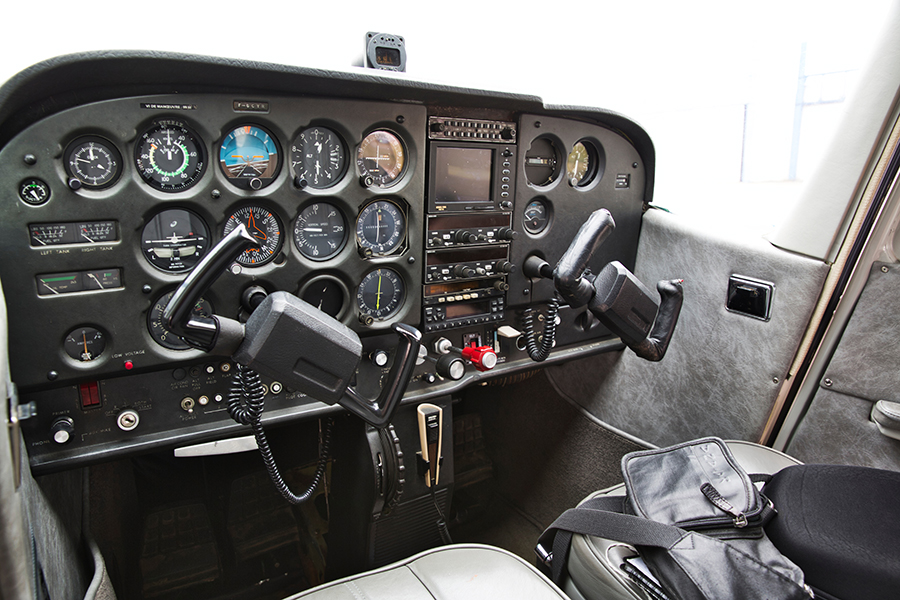-
Commercial vs. General Aviation Accidents
- Key Takeaways
-
General Aviation Accident Statistics
- Key Takeaways
-
What Causes General Aviation Accidents?
- Key Takeaways
-
What Is the Most Dangerous Phase of Flight?
- Key Takeaways
- Landing
- Takeoff and Departure
- Descent and Approach
- Fuel Management
- Maneuvering
- Weather
- Engines
- Accidents by Purpose
-
Important Lessons to Learn
-
Conclusion
Aircraft crashes are a rare but unfortunate occurrence in the world of aviation. Despite technological advances and stringent safety regulations, general aviation accidents still happen frequently compared to commercial aviation.
This article will dive into the latest general aviation accident statistics to uncover the most common causes of these incidents. From human error to equipment failure, weather conditions to maintenance issues, we’ll explore the factors contributing to aircraft crashes and what can be done to prevent them.
Join us as we shed light on a topic that is essential to ensuring the continued safety of our skies.
Commercial vs. General Aviation Accidents
Key Takeaways
- Commercial aviation is significantly safer than general aviation.
- Commercial aviation is heavily regulated and monitored to ensure adherence to strict safety standards.
- General aviation is less regulated and encompasses a broader range of aircraft and pilots, resulting in a higher frequency of accidents.
The safety of commercial and general aviation is an essential consideration for passengers and the aviation industry. While both types of aviation have seen significant improvements in safety over the years, there are still notable differences between the two in terms of the number of accidents and fatalities that occur.
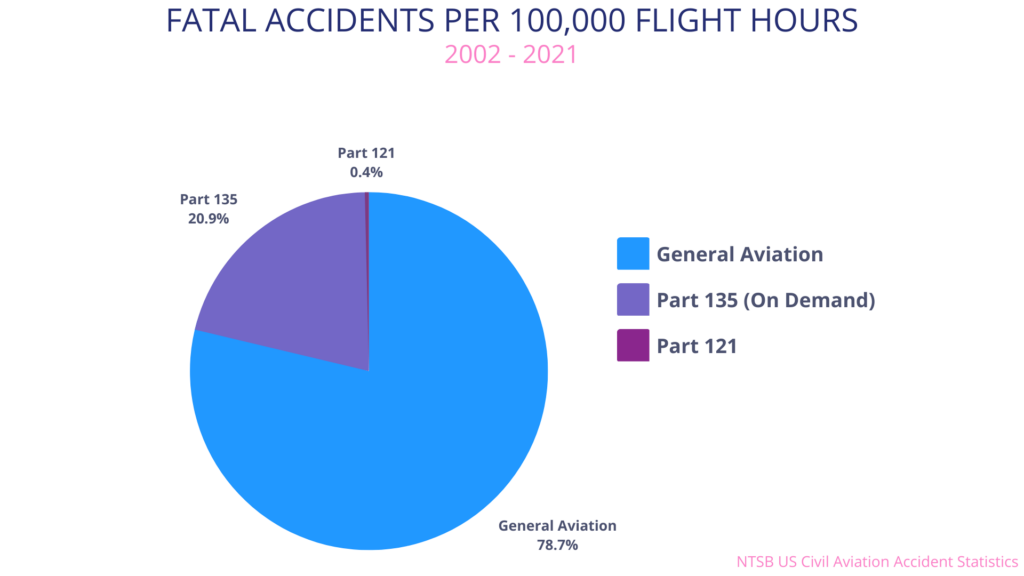
Commercial aviation is considered to be much safer than general aviation. Accidents involving commercial airlines are relatively rare and typically involve smaller passenger aircraft operated by regional airlines. The commercial aviation industry is heavily regulated and overseen by organizations such as the Federal Aviation Administration (FAA) and the International Civil Aviation Organization (ICAO), which have established strict standards for safety, maintenance, and operations. Airlines also invest heavily in technology and equipment that helps reduce the risk of accidents, such as advanced weather radar systems and redundant flight control systems. On average, a person would have to travel by air every day for 16,581 years before being involved in a fatal commercial aircraft accident.
In contrast, general aviation encompasses a much wider range of aircraft, including small single-engine planes, private jets, and helicopters. General aviation accidents are more common than those involving commercial airlines and often involve smaller aircraft. The general aviation industry is less regulated than commercial aviation, and aircraft are often not equipped with the same safety features as commercial jets. Pilots flying general aviation aircraft also tend to be less experienced and qualified when compared to commercial and airline pilots.
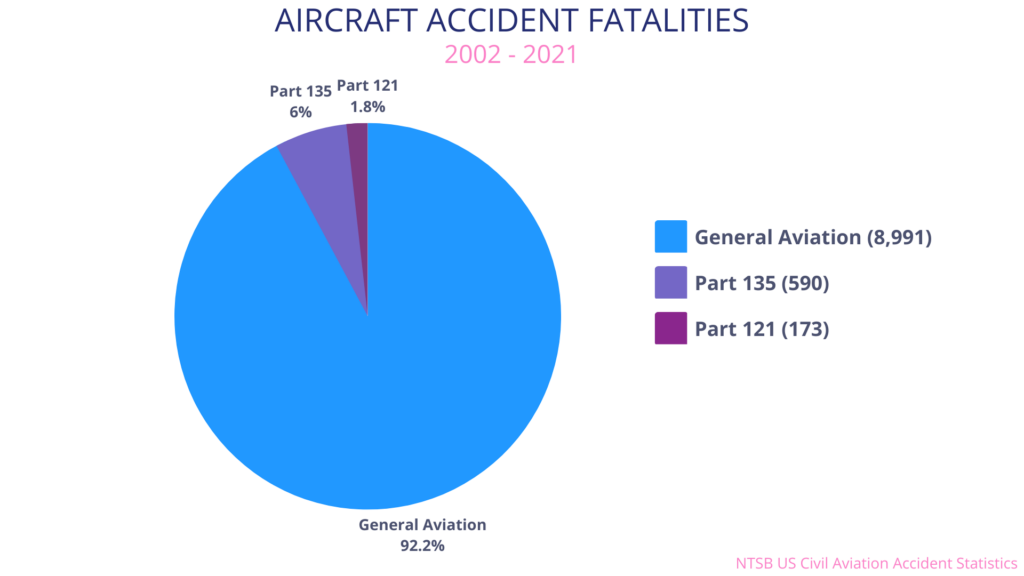
Despite the differences in safety between commercial and general aviation, both sectors continue to enhance the safety of air travel. Airlines and aircraft manufacturers constantly develop and implement new technologies and safety features, and regulatory agencies continuously update and enforce their standards. Additionally, both industries have made significant investments in training and education programs to further improve the skills and knowledge of pilots, mechanics, and other aviation professionals.
General Aviation Accident Statistics
Key Takeaways
- The general aviation accident rate has declined significantly in the last 20 years.
- The number of general aviation accidents has remained essentially unchanged in the last five years.
- Understanding why accidents happen can help us become safer pilots.
The silver lining is that general aviation is becoming safer, with the accident rate, which considers the number of hours flown, declining significantly in the last 20 years. However, the number of accidents has remained essentially unchanged in the previous five years.
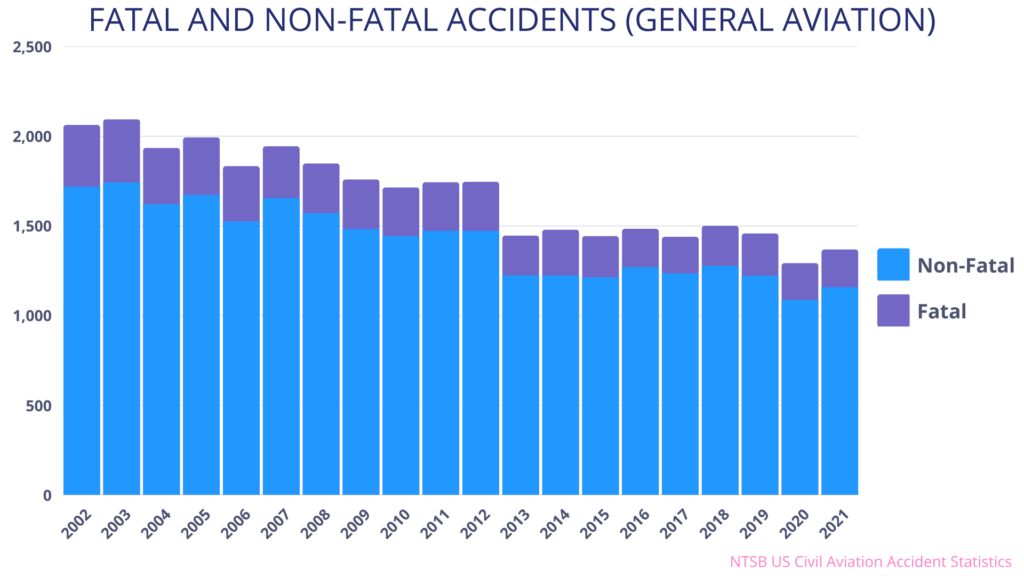
What Causes General Aviation Accidents?
Key Takeaways
- Powerplant (engine) failure, loss of control on the ground, and loss of control in the air account for the vast majority of general aviation accidents.
- The largest cause of fatal accidents is loss of control in-flight.
- Powerplant failure, an unintended flight into IMC, and CFIT also cause many fatal accidents.
- VFR-into-IMC is the primary threat in weather-related accidents, accounting for over 60% of such incidents. Thunderstorms and ice, while frightening, resulted in only one fatal accident in 2020.
- Pilot error continues to be the leading cause of general aviation accidents, with 69.1% of all general aviation accidents in 2020 caused by pilot error.
Understanding the causes behind general aviation accidents can give us a glimpse into common dangers we can avoid as pilots.
It is, therefore, crucial to understand what constitutes a typical accident. Although the specifics may vary widely, it’s essential to know the types of pilots, scenarios, and weather conditions most frequently involved in accidents.
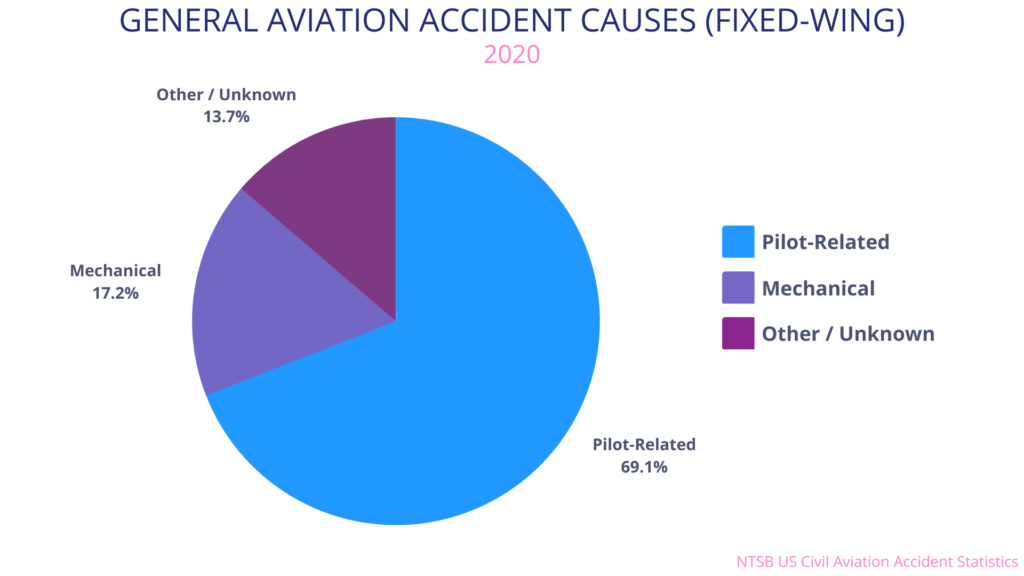
Pilot error remains a significant issue in the general aviation industry, with most accidents being attributed to mistakes made by pilots. In 2020, 69.1% of all general aviation accidents were caused by pilot error. This means that the pilot was directly responsible for the incident through a lack of knowledge or proper training, misjudgment, or poor decision-making.
The high incidence of pilot error in general aviation highlights the importance of proper pilot training, continuing education, and the implementation of safety measures to reduce the risk of accidents. The aviation industry is continuously working to address this issue by investing in training programs, improving aircraft design and technology, and promoting a culture of safety to reduce the number of accidents caused by pilot errors.

The largest cause of fatal accidents in general aviation is the loss of control in-flight. Other significant causes of fatal accidents include powerplant failure, unintended flight into Instrument Meteorological Conditions (IMC), and Controlled Flight into Terrain (CFIT).
These causes are generally related to pilot error. Many of these accidents could have been prevented if the pilots had better judgment, knowledge of aircraft systems, and a better understanding of weather patterns and general aircraft procedures. Additionally, factors such as fatigue, stress, and distractions also play a role in contributing to these types of accidents.
To mitigate the risk of these types of accidents, it is vital for pilots to regularly receive training and education on best practices for flight safety. This can include regular flight simulator sessions, safety courses, and education on the proper use of navigation and aircraft systems. Additional flight training with instructors, as well as the use of a safety pilot when able, can significantly reduce the risk of pilot error. Proper pre-flight planning, including a thorough review of weather conditions and procedures, can also help reduce the risk of fatal accidents.
The aviation industry also promotes safety by implementing new technologies and procedures that improve safety and reduce the risk of accidents. For example, advanced weather radar systems, GPS navigation, and traffic collision avoidance systems have helped to make flying safer.
In conclusion, while the causes of fatal accidents in general aviation are diverse and complex, it is possible to reduce the risk of these accidents through proper education, training, and technology. By working together, pilots, aviation professionals, and industry organizations can help make flying safer for everyone.
What Is the Most Dangerous Phase of Flight?
Key Takeaways
- Landings account for most general aviation accidents but are usually not fatal. However, they result in broken airplanes and higher insurance premiums for the entire industry.
- Tailwheel aircraft accidents are more likely to be landing-related compared to tricycle gear aircraft.
- Takeoff accidents are three times less frequent but over 20 times more likely to be fatal.
- Stall/spin incidents lead to the most fatal accidents, but it is worth noting that the takeoff and climb phase sees more stall accidents than descent and approach.
- Fuel management remains a persistent issue for general aviation pilots, ranking fourth on the list of pilot-related accidents.
- Over 50% of pilots involved in weather-related accidents held a Commercial or ATP certificate, indicating that weather does not discriminate based on aircraft performance or pilot experience.
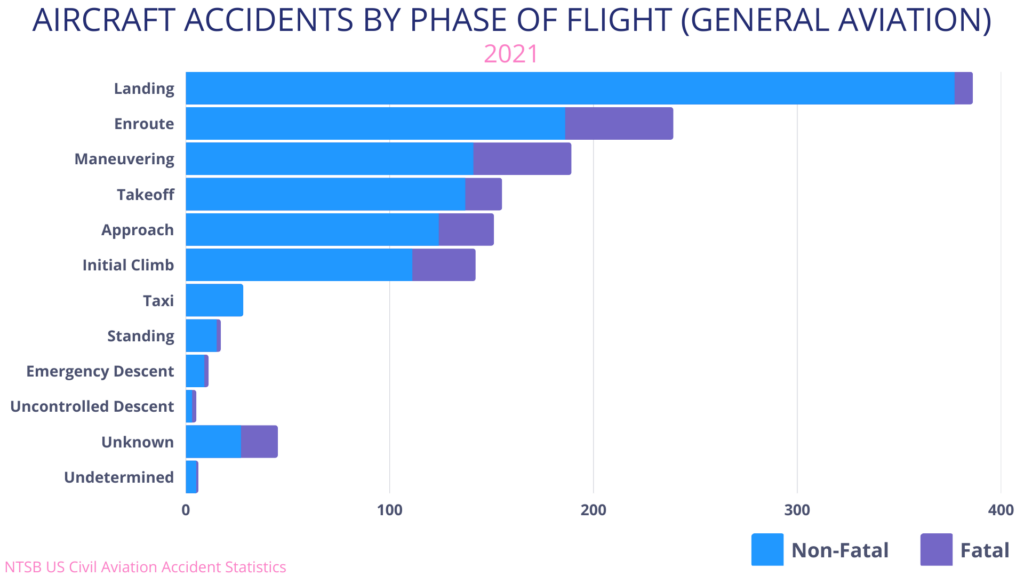
Landing
A closer look at statistics from 2021 reveals that the most frequent type of pilot-related accidents is during landing, accounting for 47% of all incidents. Fortunately, 99% of these are not fatal, but they still result in damaged airplanes, eroded confidence, and higher insurance premiums for the aviation community. Furthermore, the frequency of these incidents has been increasing, and these so-called “fender benders” shouldn’t be ignored.
Landing accidents often involve loss of control, such as a runway excursion or a ground loop. It’s not surprising that tailwheel airplanes have a higher representation in this category.
The second most common cause of landing accidents is stalling, followed by hard landings. Only a small number of incidents are due to short or contaminated runways.
These may seem like mundane scenarios, but that is precisely what makes them dangerous. Improving one’s landing skills should be the top priority, as these accidents are the most frequent. Practicing slow flight, maintaining a consistent airspeed during the final approach, knowing when to go around, and staying current with regular flights are crucial to avoiding accidents. This is especially important for tailwheel airplane pilots, as many accidents involve barely proficient pilots attempting to land in gusty winds or on unfamiliar runways.
Takeoff and Departure
On the other hand, takeoff accidents are three times less frequent but over 20 times more likely to be fatal. Most takeoff accidents involve loss of control, either a runway excursion or a stall during takeoff. Factors such as density altitude, weight and balance, and pilot technique all play a role.
Many of these accidents are tragically preventable. Proper weight and balance and takeoff performance calculations, as well as the decision not to depart in unfavorable weather conditions, would have likely prevented most of the accidents in this category.
The National Transportation Safety Board (NTSB) reports indicate that takeoff accidents deserve more attention than the feared approach and landing. To improve this record, pilots can set conservative personal minimums for takeoff performance, conduct thorough pre-takeoff briefings on every flight, and focus on crosswind takeoff skills just as much as crosswind landing skills.
Descent and Approach
The second leading cause of pilot-related accidents is descent and approach. Stall/spin incidents lead to the most fatal accidents, but it is worth noting that the takeoff and climb phase sees more stall accidents than descent and approach.
Collisions cause the majority of accidents in this phase, reminding us that following standard procedures and maintaining situational awareness is crucial when entering the pattern at a non-controlled airport.
Pilots in the general aviation category often overlook crucial procedures such as the use of standard phraseology in the cockpit and on the radio. Additionally, the execution of standardized procedures such as the traffic pattern entry should not be dismissed as redundant.
Fuel Management
Fuel management remains a persistent issue for general aviation pilots, ranking fourth on the list of pilot-related accidents. Although there has been improvement in recent years, with 2018 having the second lowest number of fuel management accidents in the past decade (excluding 2020 and 2021), over 50 aircraft are still damaged, and around half a dozen fatalities occur each year due to this preventable problem. The majority of these accidents (60%) occur due to poor planning or inadequate in-flight decision-making, while 40% are caused by fuel starvation, where the aircraft had fuel, but the pilot couldn’t access it.
There should be no excuse for these types of accidents. Proper planning is an essential duty of any pilot. These fuel management accident statistics show that there remains a significant number of pilots who do not maintain this responsibility.
Maneuvering
It’s worth noting that over half of maneuvering flight accidents involve terrain or wires and that a large proportion of these accidents involve taildraggers. This raises the question of whether some low-altitude “bush pilot” flights may be to blame.
Weather
Weather-related accidents, a frequently discussed topic in articles, videos, and seminars, continue to decline, with the accident rate decreasing by 65% in the past decade and 41% in the past five years. The availability of datalink weather and improved weather forecasts may play a role in this trend.
VFR-into-IMC is the primary threat in weather-related accidents, accounting for over 60% of such incidents. Thunderstorms and ice, while frightening, resulted in only one fatal accident in 2020.
It’s noteworthy that single-engine fixed-gear aircraft are involved in only 22% of weather accidents. High-performance aircraft, which often travel long distances and fly IFR more frequently, are involved in fatal accidents at a higher rate than their numbers suggest. Over 50% of pilots involved in weather accidents held a Commercial or ATP certificate, indicating that weather does not discriminate based on aircraft performance or pilot experience.
Engines
Although airplane engines have greatly improved in reliability over the past 75 years, they remain a top contributor to mechanical accidents, accounting for over 60% of such incidents in 2020.
Regarding accident causes, problems with the powerplant come in second only to landing-related loss of control. It’s important to note that these statistics exclude issues with fuel management and instead refer to instances of actual power loss, be it partial or complete. In 2019, 132 powerplant problems were recorded, comprising roughly 13% of all non-commercial fixed-wing accidents.
Accidents by Purpose
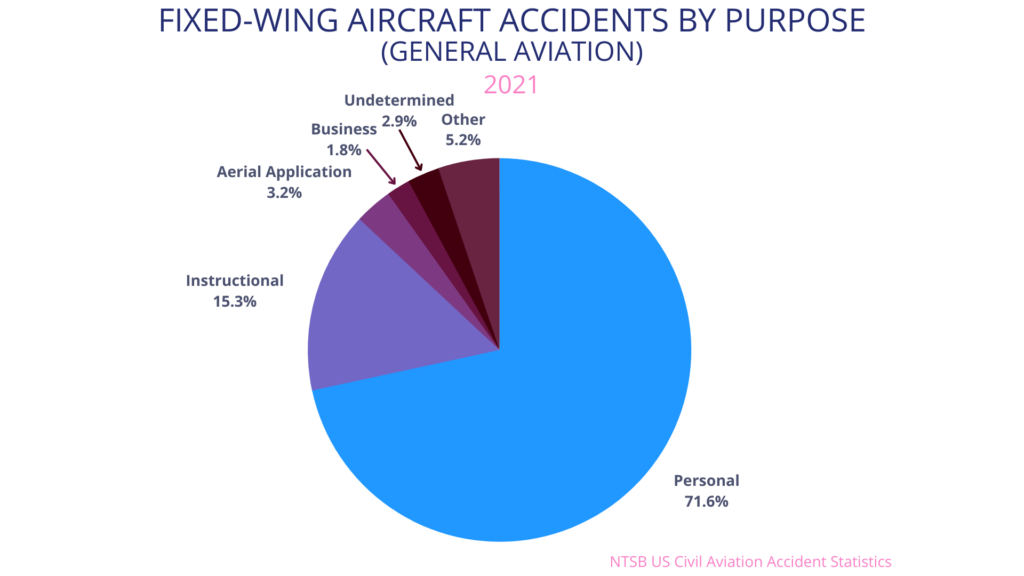
An often overlooked general aviation statistic is that of aircraft accidents by purpose. We can see from the data that, as expected, the majority of general aviation accidents are personal flights, followed by instructional.
Important Lessons to Learn
What can we learn, as pilots, from this information?
First off, no one is immune to mistakes. A significant portion of accidents involved experienced pilots, some with commercial or ATP certificates.
Second, the majority of general aviation accidents are due to entirely preventable causes. From stall/spin incidents to VFR-into-IMC and fuel mismanagement, adhering to rules and regulations is a surefire way to prevent yourself from becoming a statistic.
Thirdly, adhere to personal minimums. When it comes to personal minimums, it’s essential to be aware of your own limitations and the limitations of your aircraft. This includes minimum flight visibility, minimum altitude, and minimum weather conditions that you are comfortable flying in. It’s always better to err on the side of caution and not take off if conditions do not meet your personal minimums. Self-awareness and discipline would have prevented a large number of accidents.
Finally, receive training and practice. Regular flight training and proficiency checks can help you stay sharp, develop better skills, and become more confident in the air. It’s also important to practice emergency procedures regularly so you are prepared and know how to react in case of an emergency. Taking advantage of training opportunities and staying current with your flying skills can significantly reduce the chances of an accident happening. With the dramatic increase in fidelity (and drop in cost) of home flight simulators, adding one to your tool belt should be a strong consideration.
Conclusion
The aviation industry strives for safer skies for commercial and general aviation. While commercial aviation has seen significant improvements in safety due to strict regulation and monitoring, general aviation still faces challenges due to the diverse range of aircraft and pilots involved.
The general aviation accident rate has declined significantly in the past 20 years but remained essentially unchanged in the past five years. Understanding the causes of accidents can help us become safer pilots and prevent future incidents.
While there is still much work to be done to make general aviation safer, the industry has made significant strides in reducing the number of accidents and improving safety. By understanding the causes of accidents, pilots can make informed decisions and help prevent future incidents.
